#knowledge articles
Explore tagged Tumblr posts
Text
Brizo Perse
Brizo (according to internet) was a Goddess of sailors, mariners, and fishermen- and a prophetic Goddess specialising in the interpretation of dreams.
Brizo- meaning to slumber.
Brizo- who was worshipped on Delos.
#athenide au#Epithet#perpollo#I did not study classics#I have no idea of the timeline of myths or worship#I occasionally read wiki articles#So basic PJO fandom surface level of knowledge about greek myth
68 notes
·
View notes
Text
Imagine the reason Severus Snape agreed to join the Death Eaters wasn't any of the reasons everyone else had of hating muggleborns and muggles and agreeing with Voldemort's ideaology
And it wasn't because he wanted to lash out and hurt people because he was hurting like the other bitter kids
And it wasn't because he was forced into it like other weaker kids
Imagine it wasn't for any of those reasons.
Instead, it was for knowledge.
Severus Snape, the boy who invented curses, hexes, and spells. Severus Snape, who knew more of those in his first year than any of the seventh years. Severus Snape, who rewrote text books.
He joined the Death Eaters because he was tempted by knowledge. Knowledge of dark, forbidden magic. Knowledge of terrible, frightening power. Knowledge of things he had never had the chance to learn.
Imagine it was Lucius who approached him, knowing that Severus was a genius who wasn't satisfied with what Hogwarts taught and wanted more, wanted the freedom to explore and learn and experiment in ways that shocked people. Or perhaps it was his housemates, who decided that, poor he may be and impure his blood is, Severus was a formidable weapon to whichever side he ended up on, and they decided to convince him to join them before Dumbledore asked Severus to join him. And they promised Severus he would be free to experiment and learn as he pleased without the limits Hogwarts had enforced.
And he agreed, and became Voldemort's most precious student. He was but a boy, the youngest of the Death Eaters, yet his talent was equal to Bellatrix Lestrange herself. The two were of the most talented that Voldemort taught and he couldn't help but notice the small boy who was equal to an adult, who could grow to become the most powerful wizard to ever live. Unfortunately for him, the boy's heart was too gentle, too tender to be put on the field just yet, and his tongue was too smooth and his mind too sharp for he easily slipped away in times of action. He was a scholar, a poet, an artist. Not a soldier.
No matter. Voldemort could wait. Eventually the boy would become a man, a man with a brilliant mind but no heart, if he was encouraged to seek knowledge even at the expense of others. It was Voldemort's own fault to assume a great mind would cancel a great heart.
And so Severus Snape sold his freedom, his goodness, for the pursuit of knowledge.
Only to sacrifice it all when the knowledge he shared was the thing that put the one he loved in danger.
#this is based off something i read in this mugglenet article about snape joining them maybe for knowledge#severus snape#pro snape#pro severus snape
232 notes
·
View notes
Text

16|05|2025
I can't seem to catch a break lately, but at least I got top extention for my corner bookshelves and reorganized my fiction books, so I got the sweet sweet illusion of control for half a day. Aside from Things happening, and bad nights of sleep, I finally got meds for my mental health so that's a big happy news. I know it will take some time to have results, but I am glad I finally have that support to help me as well. As for my study progress, yesterday I finished writing notes for the book on Magellan, which means I am done the the current material for that class. I only have to attend the remaining classes, keep my notes tidy, and start reviewing. I can now move on to working on the other exam I'd like to take in July. There's a lot of materials but I will approach one task at the time, starting with the main textbook.
few joys from the past few days to avoid only focusing on the horrorsTM:
went out to eat sushi with my mom
continued to wear my loop earplugs out in the world, especially in shopping centres and I cannot stress enough how much I love them
got my bookshelves extentions which meant both assembling ikea stuff and reorganizing my books (I also had to assemble a small wardrobe for my mom so it was a win win, assembling ikea furniture is so relaxing to me so I basically had a day of activieties that make me feel relaxed and good about life)
planted a new flower in the garden and I am also considering getting more roses (watch me become the grandma from a house with good bones lmao)
finally got meds so big yaay for that
#i am so sleepy i started working on a book and i had to switch bc i couldn't make sense of what it said#i also realized i had already read the book like 5 years ago and apparently hated it so yay#that will be for another day i guess#i instead started reading an article which seems written clearly and that i can focus on bc i have some background knowledge#i doubt today will be a productive day#studyblr#studyinspo#uniblr#university#journal#studying#productivity#journaling#bookshelves#book#bookblr#booklr#knife gang#mine#the---hermit
54 notes
·
View notes
Text
Explained: Why Red Bull swapped Liam Lawson and Yuki Tsunoda

Lawson’s disastrous Australian GP weekend, in which he failed to clear Q1 after a solid, if unspectacular, Friday practice had Marko already pressing the panic button to have Lawson swapped out immediately. With Lawson’s head already drooping, the Chinese Grand Prix weekend did little to assuage the issues. Not only was he unable to find pace, grip, or confidence, but his demeanour had become concerning – the normally quite chipper and upbeat Kiwi had become somewhat despondent and morose, with one source revealing Lawson had spent most of his weekend apologising to anyone present about his lack of competitiveness. With the seat having been up in the air between Lawson and Tsunoda just over three months ago, Lawson’s rapid change of mental state meant the scales tipped back firmly in Tsunoda’s direction. This was despite Lawson’s social media use being restricted by the team following his announcement of his drive due to the extent of the negativity shown towards him by various fanbases. A source has indicated to PlanetF1.com that the feeling in the camp was that it was a little too much, too soon, for Lawson – the reality of stepping up as a rookie to race alongside F1’s current talisman, Max Verstappen, under the weight of expectation and the pressure of delivering when his predecessors had not, got to him in ways that weren’t foreseen. While the RB21 is undoubtedly a tricky beast, as Lawson made clear by his reveal of how he was struggling to get the car into what is a very narrow operating window, the Kiwi is understood to have been quite open about the fact that he also was not driving to the best of his abilities. Lawson, whose youthful confidence in his own abilities has now had to give way to a more humbling position, has taken a serious career blow, and it will be a devastating period of time for someone who has never had their abilities in doubt before. But it’s key to note that the journey isn’t over for Lawson – it’s in his hands from here, with Racing Bulls a likely home for the foreseeable. After all, referring back to the word “rotation” as was mentioned in the press release, what does Red Bull do if Tsunoda meets with the same struggles?
📸 by mark thompson | excerpt via PlanetF1
#i'm actually horrified#it's all about drivers mental health until it's one you don't like huh#this knowledge is going to haunt me forever. im never going to recover i think#liam lawson#ll30#yuki tsunoda#yt22#red bull racing#rbr#formula one#f1#formula 1#red bull f1#racing bulls#visa cash app rb#vcarb#article
71 notes
·
View notes
Text
About the entanglement of "science" and Empire. About how children are encouraged participate in these imperial "scripts".
Was thinking about this recent thing:
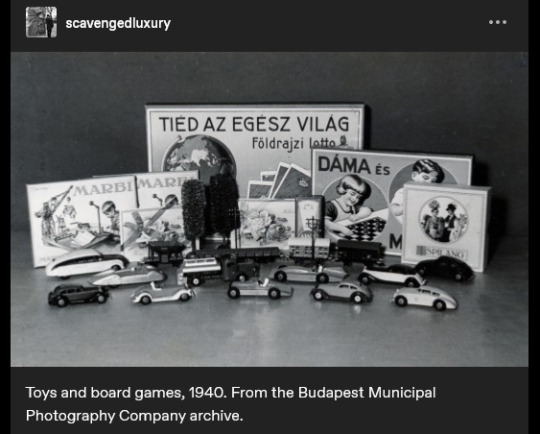
The caption reads: "Toys and board games, 1940." And I think the text on the game-box in the back says something like "the whole world is yours", maybe? (Use of appeals to science/progress in imperial narratives is a thing already well-known, especially for those familiar with Victorian era, Edwardian era, Gilded Age, early twentieth century, etc., in US and Europe.)
And was struck, because I had also recently gone looking through other posts about the often-strange imagery of children's material in late nineteenth- and early twentieth-century US/Europe. And was disturbed/intrigued by this thing:
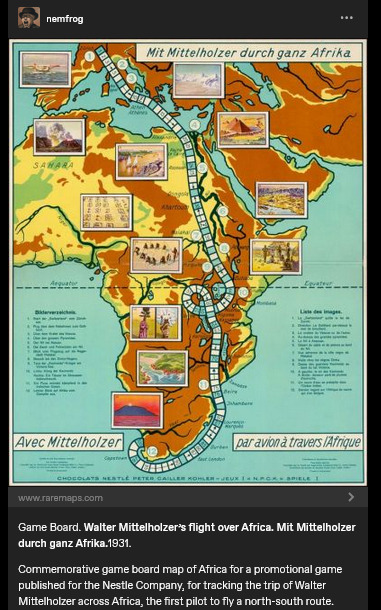
Caption here reads: "Game Board. Walter Mittelholzer's flight over Africa. [...] 1931. Commemorative game board map of Africa for a promotional game published for the N*stle Company, for tracking the trip of Walter Mittelholzer across Africa, the first pilot to fly a north-south route."
Hmm.
I went to learn more about this: Produced in Switzerland. "Africa is for your consumption and pleasure. Brought to you by the N#stle Company!" (See the name-dropping of N#stle at the bottom of the board.) A company which, in the preceding decade, had shifted focus to expand its cacao production (which would be dependent on tropical plantations). Adventure, excitement, knowledge, science, engineering prowess, etc. For kids! (In 1896, Switzerland had hosted a "human zoo" at the Swiss Second National Exhibition in Geneva, where the "Village Noir" exhibit put living people on display; they were over two hundred people from Senegal, who lived in a "mock village" in Geneva's central square.)
Another, from a couple decades earlier, this time English-language.
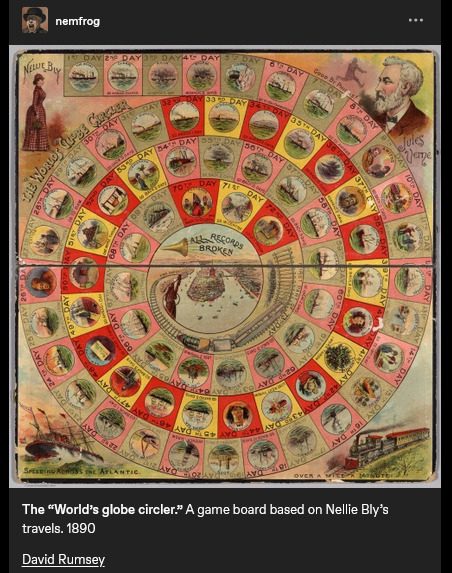
Caption reads: "The "World's globe circler." A game board based on Nellie Bly's travels. 1890." At center, a trumpet, and a proclamation: "ALL RECORDS BROKEN".
Went to find more info: Lithographed game board produced in New York. Images on the board also show Jules Verne; Bly, in real-world travels, was attempting to emulate the journey of the character Phileas Fogg in Verne's Around the World in Eighty Days (1872).
Game produced in the same year that the United States "closed the frontier" and conquered "the Wild West" (the massacre at Wounded Knee happened in December 1890). A couple years later, the US annexed Hawai'i; by decade's end, the US military was in both Cuba and the Philippines. The Scramble for Africa was taking place. At the time, Britain especially already had a culture of "travel writing" or "travel fiction" or whatever we want to call it, wherein domestic residents of the metropole back home could read about travel, tourism, expeditions, adventures, etc. on the peripheries of the Empire. Concurrent with the advent of popular novels, magazines, mass-market print media, etc. Intrepid explorers rescuing Indigenous peoples from their own backwardness. Many tales of exotic allure set in South Asia. Heroic white hunters taking down scary tigers. Elegant Englishwomen sipping tea in the shade of an umbrella, giggling at the elephants, the local customs, the strange sights. Orientalism, tropicality, othering, paternalism, etc.
I'd lately been looking at a lot of work on race/racism in British scientific and pop-sci literature involving natural history or geographical imaginaries. (From scholars like Varun Sharma, Rohan Deb Roy, Ezra Rashkow, Jonathan Saha, Pratik Chakrabarti.) But I'd also lately been looking at Mashid Mayar's work, which I think closely suits this kinda thing with the board games. Some of her publications:
"From Tools to Toys: American Dissected Maps and Geographic Knowledge at the Turn of the Twentieth Century". In: Knowledge Landscapes North America, edited by Kloeckner et al., 2016.
"What on Earth! Slated Globes, School Geography and Imperial Pedagogy". European Journal of American Studies 16, number 3, Summer 2020.
Citizens and Rulers of the World: The American Child and the Cartographic Pedagogies of Empire, 2022.
Discussing her book, Mayar was interviewed by LA Review of Books in 2022. She says:
[Quote.] Growing up at the turn of the 20th century, for many American children, also meant learning to view the world through the lens of "home geography." [...] [T]hey inevitably responded to the transnational whims of an empire that had stretched its dominion across the globe [recent forays into Panama, Cuba, Hawai'i, the Philippines] [...]. [W]hite, well-to-do, literate American children [...] learned how to identify and imagine “homes” on the map of the world. [...] [T]he cognitive maps children developed, to which we have access through the scant archival records they left behind (i.e., geographical puzzles they designed and printed in juvenile periodicals) [...] mixed nativism and the logic of colonization with playful, appropriative scalar confusion, and an intimate, often unquestioned sense of belonging to the global expanse of an empire [...]. Dissected maps - that is, maps mounted on cardboard or wood and then cut into smaller pieces that children were to put back together - are a generative example of the ways imperial pedagogy [...] found its place outside formal education, in children's lives outside the classroom. [...] [W]ell before having been adopted as playthings in the United States, dissected maps had been designed to entertain and teach the children of King George III about the global spatial affairs of the British Empire. […] [J]uvenile periodicals of the time printed child-made geographical puzzles [...]. [I]t was their assumption that "(un)charted," non-American spaces (both inside and outside the national borders) sought legibility as potential homes, [...] and that, if they did not do so, they were bound to recede into ruin/"savagery," meaning that it would become the colonizers' responsibility/burden to "restore" them [...]. [E]mpires learn from and owe to childhood in their attempts at survival and growth over generations [...]. [These] "multigenerational power constellations" [...] survived, by making accessible pedagogical scripts that children of the white and wealthy could learn from and appropriate as times changed [...]. [End quote.] Source: Words of Mashid Mayar, as transcribed in an interviewed conducted and published by M. Buna. "Children's Maps of the American Empire: A Conversation with Mashid Mayar". LA Review of Books. 11 July 2022.
Some other stuff I'd recently put in a to-read list, specifically about European (especially German) geographical imaginaries of globe-as-playground:
The Play World: Toys, Texts, and the Transatlantic German Childhood (Patricia Anne Simpson, 2020) /// "19th-Century Board Game Offers a Tour of the German Colonies" (Sarah Zabrodski, 2016) /// Advertising Empire: Race and Visual Culture in Imperial Germany (David Ciarlo, 2011) /// Learning Empire: Globalization and the German Quest for World Status, 1875-1919 (Erik Grimmer-Solem, 2019) /// “Ruling Africa: Science as Sovereignty in the German Colonial Empire and Its Aftermath” (Andrew Zimmerman. In: German Colonialism in a Global Age, 2014) /// "Exotic Education: Writing Empire for German Boys and Girls, 1884-1914". (Jeffrey Bowersox. In: German Colonialism and National Identity, 2017) /// Raising Germans in the Age of Empire: Youth and Colonial Culture, 1871-1914 (Jeff Bowersox, 2013) /// "[Translation:] (Educating Modernism: A Trade-Specific Portrait of the German Toy Industry in the Developing Mass-Market Society)" (Heike Hoffmann, PhD dissertation, Tubingen, 2000) /// Home and Harem: Nature, Gender, Empire, and the Cultures of Travel (Inderpal Grewal, 1996) /// "'Le rix d'Indochine' at the French Table: Representation of Food, Race and the Vietnamese in a Colonial-Era Board Game" (Elizabeth Collins, 2021) /// "The Beast in a Box: Playing with Empire in Early Nineteenth-Century Britain" (Romita Ray, 2006) /// Playing Oppression: The Legacy of Conquest and Empire in Colonialist Board Games (Mary Flanagan and Mikael Jakobsson, 2023)
#mashid mayar book is useful also the Playing Oppression book is open access online if you want#in her article on slated globes mayar also mentions how european maps by 1890s provoked a sort of replete homogenous filling in of globe#where european metropole thought of itself as having sufficiently mapped the planet by now knit into neat web of interimperial trade#and so european apparent knowledge of globe provided apparently enlightened position of educating or subjugating the masses#whereas US at time was more interested in remapping at their discretion#a thing which relates to what we were talking about in posts earlier today where elizabeth deloughrey describes twentieth century US#and its aerial photographic and satellite perspectives especially of Oceania and Pacific as if it now understood the totality of the planet#ecologies#tidalectics#geographic imaginaries#mashid mayar#indigenous pedagogies#black methodologies#tigers and elephans#victorian and edwardian popular culture#my writing i guess
142 notes
·
View notes
Text
The F1 driver who takes every opening he sees
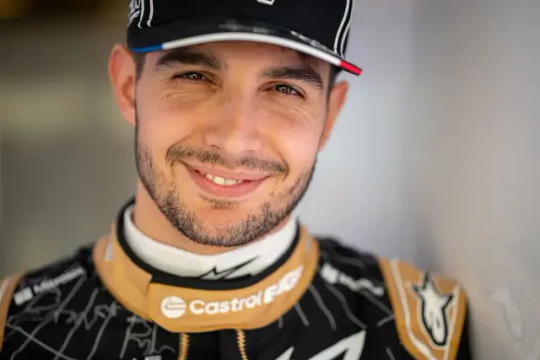
A mechanic’s son, Esteban Ocon took an unlikely path to an F1 driver’s seat. Now he’s fighting to keep it.
MONTE CARLO, Monaco — The mechanic’s son walks past women in bright dresses and men in fine suits, many of them sipping champagne. He breathes in the salty air of the Mediterranean, its shoreline neither rocks nor sand but dozens of mega-yachts.
The Monaco Grand Prix, held each May, is the global peak of sports opulence, less street race than picture postcard from high society: A-listers and royals toasting the good life in the richest place on Earth. Several Formula One drivers live here, their plain-sight hideaway amid a Netflix-fueled fascination with their sport. Among them are Max Verstappen and Lewis Hamilton — champions, multimillionaires and household names in a sport Hamilton has called a “billionaire boys club.”
Esteban Ocon, though, is not of this world. When Ocon was a karting wunderkind, other drivers would sneer at him and scoff, whispering that the only child of a dumpster-diving mechanic doesn’t belong. That the Frenchman, now 28, will forever be a [wanderer] playing dress-up in a place such as Monaco. Even after eight years on the grid, he remains an outsider.
Then again, an impressive finish here would change minds. It might even change Ocon’s, convincing him it’s possible to be born into one end of the economic spectrum and, with enough talent and moxie, reach the other.
He changes out of his jeans and into an Alpine race suit. He stretches the muscles on his thin frame and climbs into a $15 million super machine. The green flag drops. Ocon accelerates, 0 to 100 mph in 2½ seconds, trying to position himself and his team for an early chance at points. Over the years, he has proved himself as a skilled and fearless driver, aggressive sometimes to the point of recklessness.
With Monaco’s narrow streets and hairpin turns, passing is dangerous. Three-time world champion Nelson Piquet once compared it to riding a bicycle in your living room. And trying to pass a teammate? It simply isn’t done.
Before the race, in fact, Alpine instructed its drivers to avoid each other. Whoever is ahead after the first lap should stay there; the driver behind him is to protect his blind side.
Midway through the first lap, the cars are clustered. Pierre Gasly, Alpine’s other driver, is immediately in front of Ocon. On the eighth turn, just before the circuit’s famed tunnel, Gasly eases off the accelerator. Ocon sees his teammate drift left, allowing space between Gasly and the wall, creating an opening.
FIVE HUNDRED MILES NORTH, there’s a small French village built into the lush countryside. People in Évreux raise chickens, recycle batteries, mow their own grass. And the locals tell of a man north of town who could bring back the dead, so long as the corpse had four wheels.
One of those locals, Marc Guillouet, still remembers the sound of Laurent Ocon’s air compressor bellowing at all hours as Ocon performed reconstructive surgery on another broken-down used car that had been towed through his gate. Then, hours later, another sound: the engine humming back to life.
“The way he refurbished it,” Guillouet says, “it was like new.”
Laurent was a self-taught mechanic who built his shop onto the back of the Ocons’ home, a single-car garage jutting out in yellow stucco. It was in the house’s rear, but it acted as the family’s entrance. Before school some mornings, young Esteban would see his father, grease up to his elbows, still trying to solve the previous night’s puzzle. When Esteban returned in the afternoon, he would watch Dad beamas he turned the key, listened and … there it was, that beautiful music.
“We live for that,” Esteban says now. “He wants to win, like me.”
Laurent’s passion was reviving machines. His son’s was maneuvering them. Esteban says he was 4 the first time he got behind the wheel of a go-kart, gliding around the track at an amusement park, through cones and around other karts as if it were second nature. His friend who came along drove straight into the wall.
Esteban kept driving, testing himself in bigger, faster, more complex machines. The families of some other 8-year-olds hired engineers, barked into radios and traveled with professional mechanics. But Laurent and wife Sabrina had no money for that. If Esteban’s carburetor failed or his torsion bar broke, it was Laurent who mounted a new one. Then they would return to Évreux from Ambourville or Rouen, often with Esteban cradling another trophy.
“We tried to protect Esteban from pressure as much as possible,” Laurent says, answering questions emailed by The Washington Post. “But unfortunately, the only solution is to perform.”
After one of Esteban’s races, a representative from a management company approached. The boy had the talent to make racing his career, the man said, but it wouldn’t be easy. Or cheap.
Thousands of European kids grow up dreaming of the Formula One life, waiting to pilot a rocket at circuits such as Monza and Silverstone and Monaco. Most never make it, and even those who only come close do so after millions have been spent on equipment, travel and engineering.
The families of many drivers commit hundreds of thousands before their child becomes a teenager, largely to get noticed by top feeder programs and driver academies. Among the hopefuls are the kids of billionaires and oligarchs, able to bankroll the pursuit of a nine-figure dream. A few even pay their way onto the F1 grid, with cash-strapped teams agreeing because it transfers the financial responsibility.
Most, though, spend years working their way up.
“Even if you are talented,” Esteban says, “if you don’t have the right people, you don’t manage.”
But all he had were his parents.
“If he really wants to do it,” Esteban remembers hearing Laurent say years ago, “we’ll give him everything we can.”
LAURENT AND SABRINA SOLD THEIR HOUSE and the family business, leaving behind anything that didn’t fit in a 21-foot motor home. They stuffed Esteban’s mini-kart into the rear of a van, surrounded it with tools and Esteban’s toys, then hitched the motor home to the van’s rear.
“Prepping,” Esteban’s parents told him, “for the rest of your life.”
With Évreux in the rearview, home now was a parking lot in Lyon or a roadside in Le Mans. Ten-year-old Esteban had his bicycle and the family border collie to keep him company. Sabrina outfitted the motor home with a fake fireplace and told friends it was their mobile chateau. Le Palais des Ocons had a living room and shared sleeping quarters, with views that were a mountain some days, a vineyard others.
Sabrina and Laurent convinced their son that each day was an adventure, each morning a chance for Esteban to open the door so he and their dog, Viper, could breathe in a dramatic new backdrop. He and Laurent sometimes went on long bicycle rides, where they talked about engines, racing, the future. Then the convoy headed to a nearby track, where the soft-spoken Esteban slid on a helmet, climbed into his kart and transformed into an assassin. There wasn’t an opening he wouldn’t hit, a pass he wouldn’t attempt, a throat he wouldn’t cut. Esteban wanted to win races, yes, but victory was about more than bragging rights.
In his 9-year-old mind, he says, it was the only way to repay his parents.
“I had weight on my shoulders very early,” he says. “There was never a Plan B in my head.”
In 2006, Esteban, then 10, won the regional mini-kart championship, which qualified him for a spot in the French Cup’s “Minime” division. He reached the final heat, and he and another young star, Charles Leclerc, angled for positioning on the last lap. Esteban went inside, trying to overtake Leclerc, and their tires touched. Leclerc spun out and hit the wall; Esteban recovered but finished outside the top five. The two boys spent the rest of the day crying.
The family returned to Évreux each winter, staying with family so Esteban could attend a few months of school before the new season. Otherwise, they kept moving, rarely in the same place for more than a few days.
Esteban won the French Cup in 2007, the “Cadet” title a year later, the junior championship in 2010. With every promotion came longer trips and more expensive gear. An entry-level “baby” kart costs about $3,000, not including registration fees and fuel, and a used mini-kart engine and chassis can be twice that.
By 2011, with a promotion to Winning Series Karting, the chateau was crossing borders so Esteban could race in Spain, Italy and Portugal. Entry fees alone were upward of $5,000 per race, with fuel and spare parts pushing the cost higher. All youth sports have their own unique cultures, and in this one, there is an established taboo: Kids don’t talk about their parents’ wealth.
But chatter happens anyway. Jos Verstappen, father of 14-year-old Max, used to drive in Formula One and spent $1 million bankrolling his son’s career. Leclerc grew up among the yachts and Ferraris of Monaco, and Lance Stroll’s dad, Lawrence, was a fashion billionaire.
Esteban’s folks?
Homeless, the other boys murmured. Sometimes, they said, they even saw his dad lurking near the circuit, waiting to pull other drivers’ used tires out of the trash.
IN 2014, OCON, THEN 18, won nine races and finished in the top three in 21 of 33 races to claim Europe’s Formula Three championship. But it was 17-year-old Verstappen, who had finished third, who was promoted seven months later and became the youngest driver ever to appear on the F1 grid.
“My dad always said it’s not going to be easy,” Ocon says now. “I didn’t really know what my future would be.”
He spent the 2015 season with Mercedes and Lotus — discussed alongside Verstappen, George Russell and Gasly as the sport’s next generation of starsbut still toiling in its minor leagues.
The next season, another young driver, Indonesia’s Rio Haryanto, won a spot with Manor Racing, a fledgling F1 team from Britain. F1 teams today operate under an annual maximum budget. Back then, though,the annual cost for a two-car team could reach nearly $200 million per year. Some teams have lucrative sponsorship agreements and investments from engine manufacturers, but others rely only on prize money and the potential share of a year-end financial pie that is distributed to the teams that finish in the top 10 in points.
Haryanto started the first 12 races that year before Manor dropped him — and not just because he never finished better than 15th. It was because Haryanto, initially backed by a $16.65 million investment from an Indonesian oil and gas company, ran out of money.
Manor’s own survival depended on performance, so in August 2016, it contacted the most talented driver available and told 19-year-old Esteban to get to Belgium. A management company had agreed to underwrite Ocon’s career, so with the motor home now retired, the family traveled by plane.
“A lot of emotions and relief,” Laurent recalls. “The culmination of 16 years.”
FOUR MONTHS AFTER ESTEBAN’S F1 DEBUT, with the sport itself at a crossroads, Manor Racing announced it was broke.
It was January 2017, and this was the first of several dominos to tumble.
The next was that Force India, a well-funded team and a new contender, offered Esteban a multiyear contract after its No. 2 driver, Nico Hülkenberg, defected for Renault. With an elite car, Esteban finished seventh in Russia, fifth in Barcelona, sixth in Montreal — valuable points for his team and proof he belonged.
Then, in Azerbaijan, Ocon saw an opening. He tried to pass Sergio Perez, his Force India teammate, before their wheels touched. A moment later, he went for it again, contacting Perez’s car and damaging both vehicles.
“What did Esteban do, guys?” Perez said on his headset radio. He later called Ocon’s behavior ��unacceptable.”
Three races later, Ocon again collided with Perez in Hungary, and a week later in Belgium, Ocon tried to pass his teammate on the inside. The cars made contact, Perez’s front wing flew off, and the veteran driver’s anger exploded.
“Honestly, what the f--- is this guy doing?” Perez said. “F---ing idiot.”
High drama — which, considering the sport’s new ownership, was undoubtably welcome.
Long owned by a European private equity fund, Formula One had recently been purchased by Liberty Media, an American entertainment titan that parlayed its ownership of struggling assets, from satellite radio to the Discovery Channel and QVC, into ownership of the Atlanta Braves. It wasalready planning the all-access Netflix docuseries that would debut in 2019 — less than a year before the pandemic. When the sports calendar ground to a halt, “Drive to Survive” became a massive hit that sent each team’s value soaring.
Sponsors and investors were fighting for a piece of a sports gold rush. Not everyone could keep up, though. Force India’s owner, Vijay Mallya, defaulted on more than $1 billion in loans after his airline failed, before numerous banks accused him of fraud. (Mallya has called these accusations “rubbish” but, after fleeing India for England, is still considered a fugitive.) He sold his team to a group of investors led by Canadian billionaire Lawrence Stroll, who had made his fortune on the threads of Tommy Hilfiger and Michael Kors. And who happened to have a son, Lance, who drove, if not very well, for Williams Mercedes.
Just like that, it was Ocon being bumped, his dream blown to pieces by his own team. When the 2019 season started, he was out of a job. He blamed “politics.”
He joined Mercedes as a reserve driver, and during race weekends, he says, he would climb into a racing simulator and go through scenario after scenario until 4 a.m. On no sleep, he would go to the airport and travel to wherever F1 was because that’s also where Ocon could meet with potential investors, sponsors and engineers. Then, a week later, he would do it all again.
“I didn’t care because I said, ‘Let’s give it a full go,’ show the people how hungry I am,” he says. Failure, he told himself, would mean that his parents’ sacrifices had been in vain.
“I didn’t do all that just to sit on the side,” he continues. “Teams saw how much I was willing to give, how much I was willing to suffer. I wanted to show everyone that I’m willing to go further than anyone else. No sleep for three straight days, simulator day and night, I’m going to do it. And, yes, I’ve lost four kilos in that year and got sick seven or eight times, and the reality is, yes, I’ve suffered and it was tough. And I don’t want to be suffering forever.”
In late summer 2019, with the first season of “Drive to Survive” being filmed, Ocon’s phone rang. Renault was parting ways with Hülkenberg. The French team wanted the kid from Évreux to come home.
“A crazy moment,” Ocon says. “This was it. The tough times are over now.”
LAST YEAR IN MONACO, something happened that was highly disruptive: Ocon finished third. It was his third appearance on the podium and his best result since he won the Hungarian Grand Prix in 2021. In one of Europe’s nightclub capitals, the 27-year-old celebrated. Hard.
Fatigued, dehydrated and emotionally drained, Ocon again got sick. He was nonetheless due back on the grid in Barcelona four days later. He finished eighth in each of his next two races, then 14th, then didn’t finish the two after that.
Nobody weeps for the motorsports rock star, but a life spent in constant motion does take a toll. A year after signing with Renault, which rebranded as Alpine, Ocon was reportedly paid $5 million per year. He put Laurent and Sabrina on the payroll of “Team Esteban,” he says, assigning his mother administrative tasks and his father responsibilities such as renovating Esteban’s house. He could also hire a performance coach to keep his body and mind sharp — or as sharp as possible in a sport whose schedule features two dozen stops around the globe.
Now, years after Laurent and Sabrina tried shielding their son from many of racing’s pressures, it is Tom Clark’s job to act as Ocon’s conscience. To tell him it’s okay to sleep in on weekends, to grab a nap after practice, to avoid media and fans because more interactions mean more exposure to pathogens.To urge him to eat more lean protein and complex carbohydrates, stay ahead of time zones by wearing sunglasses to simulate darkness, use a light therapy lamp or glasses that emit a bright glow above the eyes. To encourage him to take it easy sometimes, especially when it comes to challenging teammates, and maybe to even think about gearing things down a tad.
“Let’s really just put a bubble around you,” Clark says he tells Ocon.
The problem is this is in conflict with the instincts that got Ocon here. Without deprivation and exhaustion, would he have ever left Évreux? If not for aggressive racing and a ruthless competitive drive, could he have even reached the grid? Especially when it comes to challenging teammates, can’t he gear things down a tad?
ON THE FIRST LAP at this year’s Monaco Grand Prix, there’s Gasly in 10th place. Ocon is 11th. Points are awarded to only the top-10 finishers.
The Alpine drivers have known each other since childhood, their hometowns just 20 minutes apart, friends scratching and clawing for better footing. When they were 12, both were in the same championship race. Gasly overtook Ocon on the last lap to win. “I kicked his ass,” Gasly told the Netflix documentary crew, “and he didn’t like it.”
Not long after, the French racing federation had an opening at its sports academy in Le Mans, a kind of Hogwarts for kid racers. It was Gasly who got the invitation, not the mechanic’s son. The friendship crumbled, just one more thing Ocon left behind as he boarded the motor home once more, looking to win races, yes, but also in search of acceptance.
“But look where I am now,” he says. “That has helped me to get through a lot of steps in my life. That’s what made me so competitive, I guess, from so early on.”
Ocon and Gasly hadcollided in 2023, too, in Australia, with both cars taking race-ending damage. After that, tension between the teammates boiled over when Gasly accused Alpine of coddling Ocon. Before Monaco, the team told the pair to cool it.
And they did, for all of 40 seconds. Now, seeing that narrow opening, Ocon goes for it.
His rear tire connects with Gasly’s front wheel once, then a second time, sending a bitter cloud of burned rubber into the sea air. Ocon’s car goes airborne before turning sideways, and though it lands on its wheels, the impact causes catastrophic damage.
“What did he do?” Gasly says into his radio.
Pieces of carbon fiber fly off Ocon’s car. The tire is punctured, the gearbox fried, the suspension arm broken.
“That’s it, guys,” Ocon tells his team. His Grand Prix is finished.
Needing repairs that will cost tens of thousands and with Ocon’s car due in Montreal in 10 days, Bruno Famin, Alpine’s team principal, publicly admonishes Ocon and vows “consequences.” F1’s governing body, the Federation Internationale de l’Automobile, penalizes Ocon after ruling he initiated the collision.
A week after Monaco, Alpine announces that, in 2025, it will replace one of its drivers. Neither had gotten a podium, and only Ocon had won a point for Alpine. But the team chooses to keep Gasly, meaning Ocon again will be set adrift, the [wanderer] seemingly destined to forever roam.
A FEW MONTHS AGO, Esteban and Laurent went for a long bike ride. The old man still lives near Évreux, operating a shop his son bought him. He still likes to work on cars and make music, albeit as more hobby than job, andprefers to traverse the countryside on an e-bike.
Even against his dad, Esteban can’t help himself.
“I still pull away,” he says.
First, though,during a quieter moment on a recent ride, Laurent told his son a story.
There was once another boy with talent and ambition, the story went, hoping to someday become a professional cyclist. He was as skilled as anyone, but the other kids had access to training and coaches that this boy’sfamily couldn’t afford. So lying in bed one night when he was 16, he succumbed to these economic realities and abandoned his dream, diverting his attention and passion into becoming a mechanic.
So, he went on, when that boy became a man and a husband and a dad, he and his wife agreed to do everything possible to position their son for success. To tell him about possibility, not limitation, and raise him in an environment that would eliminate regret.
“He had never told that story,” Esteban says. “That moment, basically, when he was lying on the bed like that, probably changed my life. They clearly gave more than what they could, and without them I wouldn’t be here.”
Esteban says he occasionally fantasizes about what it would be like to stay in one place: to stop moving, inhale, feel settled. Maybe someday, he says, but not just yet. In July, after Ocon was two months adrift, Kevin Magnussen announced he would be leaving Haas.
Haas, as it happens, is run by Ayao Komatsu, a former F1 engineer who had met and encouraged Esteban when he was just a teenager. A decade later, Komatsu came through. Haas offered Ocon not only a seat for 2025 but acceptance for all the things he is and is not.
“Esteban, he needs an environment that he knows the team is behind him, supporting him, listening to him,” Komatsu says. “No politics. I believe we can provide that.”
But what about the suggestion that Ocon doesn’t play well with others? That you can never take the Évreux fully out of the kid?
“If I was worried about that,” Komatsu says, “I wouldn’t sign him.”
After their bikeride, Laurent and Esteban turned around but kept talking over the wind. Farmland and hills blurred past, same as they did years ago, and a favorite memory of Esteban’s sprung to mind. It was morning, and the 12-year-old awoke in the motor home again with no idea where he was. So he opened the door to see blue sky, the slopes of great mountains, the shoreline of the Mediterranean.
Laurent had parked the van and motor home in Monaco, where yachts are moored and the best drivers live. Esteban remembers the feeling of that moment, the possibility, and his dad stepped out and said there was nothing to stop his son from racing here someday. Whatever came next would be determined by Esteban.
“There was no guarantee,” Esteban recalls his dad saying. But the boy had a chance to prove he belonged. Picturing the momentyears later, he inhaled, kept pedaling and let Laurent catch up as the two of them headed home.
#used a site to remove the paywall#so here is the whole article for those interested! <3#esteban ocon#f1#btw the things i put in brackets is bc the author used the g slur and while i get the implication#of este always being on the move in the caravan and now as adult as well#i still think it is a bit in poor taste#also be aware that this author has zero wheel knowledge bc he mentions incidents that were simply not este's fault#and feed into the dumb bad teammate narrative
146 notes
·
View notes
Text


Falathrim Drinking Vessels of Beleriand: Social Hierarchies and Utilitarian Artforms
For @tolkienekphrasisweek 2025, Day 5: Culinary Arts
Every culture incorporates a form of social hierarchy within their craftwork; oftentimes those holding the most exuberant of items can be found within the wealthier class–whether it relates to nobles or chieftains. Yet these rules need not apply to cultures that value the social hierarchy of communal contributions over name or title. It is within this tradition that the Falathrim choose to honor those with great respect in their craft of drinking vessels.
The Falathrim drinking vessels are more than decorative, and hold a utilitarian function to the owner. The iridescent paint that coats the ceramic is used to reflect starlight. This painting tradition carried into the days of the Sun and is one such example of utilitarian function blending with art. Each vessel also contained a miniature sculpture of its owner, carved to reflect their appearance. This design aspect was not only playful in nature, but it also indicated who the vessel belonged to. In examples A1 and A2, these carvings would be referred to as vessel riders.
A1 contains a female vessel rider; she appears to sit on a stylized, fanged marine mammal. In her hand she steers the great beast with an oar which also represents a large cooking spoon. It is with this understanding that she was perhaps a great cook who often fed the people of her village. Beside her, A2, shows a young man riding a large fish–he was perhaps a great fisherman during his time. Both vessels were unearthed together, and it is with wonder how they survived into the current age in decent condition as most Falathrim relics now remain lost beneath the sea. Perhaps the vessel riders knew one another and that their combined contributions in fishing and cooking are correlated.
#Tolkien Ekphrasis Week#Day 5#TEW Day 5#Falathrim Culture#couldn't help adding Ilost#I imagine this excerpt of an article was written ages later with ambiguous amounts of knowledge on the topic#silmarillion#sindar elves
48 notes
·
View notes
Text






TAEMIN | Wonderland Magazine ✦ Ephemeral Gaze London [cr. article here]
#taemin#shinee#lee taemin#ephemeral gaze london#wonderland magazine#this is such a great article to read and they really captured the essence of him#it's so detailed and passionate and knowledgeable#you just know they are a taemin fan
53 notes
·
View notes
Text
the level at which people are misusing the term "Never Again" in the far left absolutely infuriates me.
"Never Again" doesn't refer to the idea of no more genocides -- unfortunately people are evil and corrupt and seek scapegoats and destruction, there were genocides in the years following the Holocaust, there were genocides 10 years ago, there are multiple genocides going on as we speak
"Never Again" means we as Jews will pay attention to the warning signs, will not mindlessly allow antisemitism to fester and take over our communities, we will fight back. it means we will be proud. it means we will not let you hate us without a word of refusal.
"Never Again" is a warning for us, it is a reminder that what happened then can happen now -- is happening now. The Far Left doesn't get to use it against us. You don't get to turn our tragedies into hate-speech and antisemitic rhetoric.
Am Yisrael Chai
#abby speaks#that fucking NYT article made me rage so much#needed to get this out#if this somehow makes you pissed at me go ahead the unfollow button is right there#I have always said that Palestinians deserve a state and I have always believed that Israel has a right to exist#the lack of knowledge at these “protests” shocks me - people don't know which river or which sea; they don't know about the hostages#free gaza from hamas#we are allowed to mourn the “protests” started before we'd even had a chance to.#I will never ever forgive or forget the people that have made mourning still feel impossible#I am not about to sit here and say that the Israeli government is blameless#however if you didn't know that 1000s of Israeli have spent the past year protesting against Netenyahu's right wing government shut up#we need actual solutions; neither Israelis nor Palestinians are going anywhere#and you guys need to start calling out the antisemitism in your movement#I have my doubts on that actually happening and you'll never see me donate to a lot of these causes again#the goy left has lost my respect and my trust and now it only has my side-eye#sorry for the rant in the tags it's been an exhausting few months
359 notes
·
View notes
Text
just saw Sinners for the second time, holy shit it's even richer on a rewatch. i need to write essays about the themes of Catholicism and colonization and Mary being the first one taken and Grace being the one to start the final confrontation and everything to do with Annie... like holy shit the layers in this movie. im obsessed.
#im also not knowledgeable or smart enough to even start to unpick all the layers myself#i gotta read that article i saved the other day about it#sinners#sinners 2025#my post
21 notes
·
View notes
Text
man it's fun learning new stuff about America. Like what do you MEAN burger and hotdog folding paper is a thing AND DONT GET ME STARTED ON THE FOOD CHAINS
#like I learned some new ones today like papa murphy's?? I think that was the name of it???#laptop recommended some articles and one of them was every states favourite food chain#I must say I'm knowledgeable on a few#(mainly thanks to food theory)#but like. Ireland has significantly less in comparison LMAO#talking
37 notes
·
View notes
Note
i am a proponent of open borders/worldwide free movement but i do have a hard time reconciling the sovereignty of indigenous nations with the utopian world i imagine where belonging to a nation is immaterial. do you know of anyone who can talk more about this?
I don't know of a particular person I could refer you to online, but I'll outline some of the suggestions I do have for learning below.
Does anyone else know someone online who might be able to speak to this?
My personal understanding (as someone who is neither Indigenous nor an expert, so grains of salt!) is that the things Indigenous Peoples need in order to attain sovereignty are largely dictated by the colonialist system they've been forced to operate under-- which means a decent place to start is just learning about how different Indigenous Peoples have historically understood relevant concepts like what made a People a nation (or tribe, or band), membership to a particular nation, and land "ownership"/territory (if there was such a thing).
Step two, then, is learning about what sovereignty means to them now- and why. Indigenous Peoples have had vastly differing and complex relationships to land and nationhood (as we understand it now) in the past and present, many of them much closer to the ideal you're imagining than is able to exist under settler-colonialist governments like the U.S.
Modern reservations don't even all require those who live there to be members of the nation whose land they live on, nor do all members of those nations live on reservation land (some nations, like the Duwamish, don't have federal recognition or reservation land- yet still have a process for attaining membership).
The Landback movement aims to return land to the Peoples who orignally stewarded it, but that has more to do with ensuring sovereignty for Indigenous Peoples; Landback on the whole isn't really about kicking individual people off the land they live on. That anxiety comes from settlers and settler-colonialism, and fearing that what we did to them will be done to us. Not from, like, actual Indigenous people.
I'm always recommending Indigenous History Now's videos because like, the whole channel is really great, imo. I can't remember exactly which one it is that he talks about land "ownership" in traditional Coast Salish cultures, but I think it's either Indigenous History of the Pacific Northwest Coast, or Indigenous American Culture Zones: The Pacific Northwest Coast.
I think it might also help to learn a little bit about why Indigenous Peoples might prefer the term "nation", especially in a settler-colonialist context.
More valuable than any of that, though, is learning about and from the Native nations local to you. Museums & cultural centers are typically open to the public; you can always check their website to find out, or just find a person to contact and ask directly.
Native nations also tend to run events that are specifically open to the public, which tend to be listed on the nation or center's websites. Be sure to check sites for Native nations in your are that aren't federally recognized as well; a lot of them have websites and events and things anyways.
Every interaction I've had with local nations & individual Indigenous people has taught me that on the whole, Native nations here aren't just friendly, but actively want non-Natives to learn about them, from them, and are really excited when we approach with genuine curiosity & respect. I can't speak to what's true where you live, but it can really be a joy to connect in that way. There is of course also a lot of hurt, grief, and very justified distrust as well, so y'know. The genuine curiosity and respect is key, I think.
#long post#whoops#running my mouth but like I opened 30+ tabs and read several articles about it so I hope it's like. not misinfo at least#begging for more info and knowledge 🙏 pls
42 notes
·
View notes
Text
If you use these 10 phrases regularly, you have a very strong personality - DMNews
Take Your Power Back...
I had many people walk away from me because I wouldn't be who they wanted me to be and NOW, I walk away for the same reason, because I feel it early.
I have said it many times before and I will say it again: "Everyone wants a relationship without conditions but they are the ones carrying a bag of conditions." I understand at the beginning you have to get to know one another, but it doesn't take long to get through that phase. If you really want to touch my soul? Tell me about your journey, the times you stumbled and fell, the steepest mountains you had to climb, tell me about the shadows you had to fight and show me your scars. Tell me how you love yourself, and your faith you have in you.
If you don't trust yourself...
How can you trust anyone else?
If you don't love yourself...
How can you love anyone else?
Rise and Shine, put your feet on the floor cause we have work to do. 🤔
#pay attention#educate yourselves#educate yourself#reeducate yourselves#knowledge is power#reeducate yourself#think about it#think for yourselves#think for yourself#do your homework#do your own research#do some research#do your research#ask yourself questions#question everything#self help#self improvement#self love#self care#love yourself#good article#truth be told#understand#spiritual awakening#spiritual awareness#spiritual ascension#spiritual transformation#spiritual warfare#spiritual work#spiritual wisdom
26 notes
·
View notes
Text
if Richie was alive and present for the summoning
Tinky: ohohoho boy a Spankoffski, I’m going to have the whole set in my toy box!
Richie: oh fuck get behind me Pete this guy’s got the fucking prison realm
#is this a good joke ive never watched jujutsu kaisen#the extent of my knowledge is coming from a wiki article#because I got an ad for a ring based off the prison realm and my mind immediately went to the bastards box#so I had to know more#and yeah it seems like a pretty similar concept#anyways. I need to stop rambling so much in the notes#musicals#starkid#hatchetfield#hatchetverse#nerdy prudes must die#npmd
268 notes
·
View notes
Text
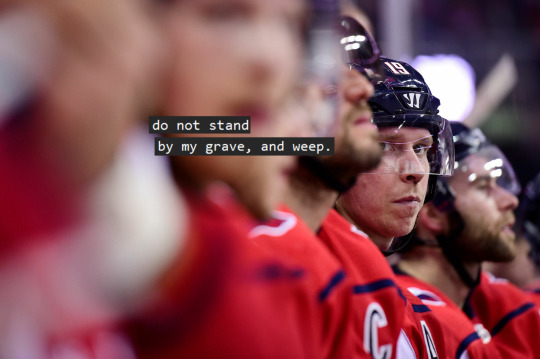
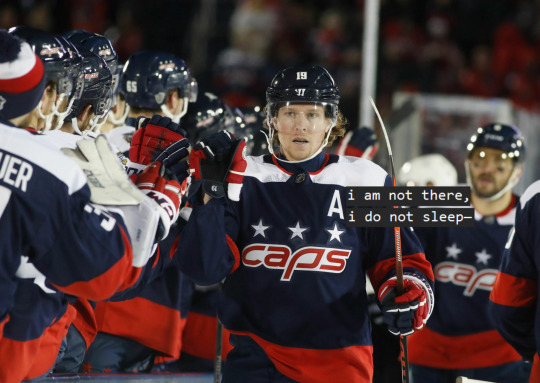
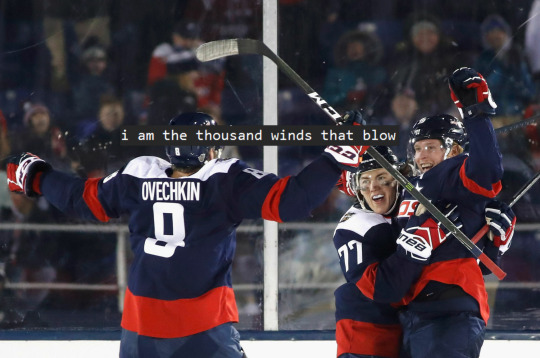

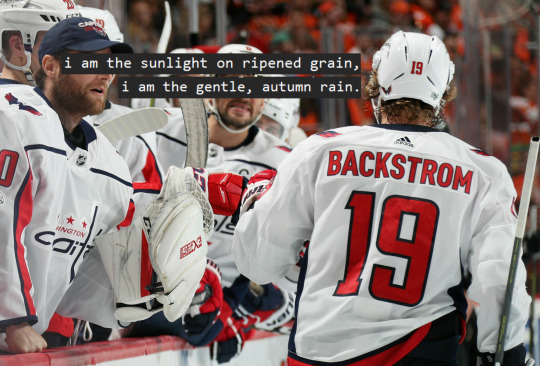
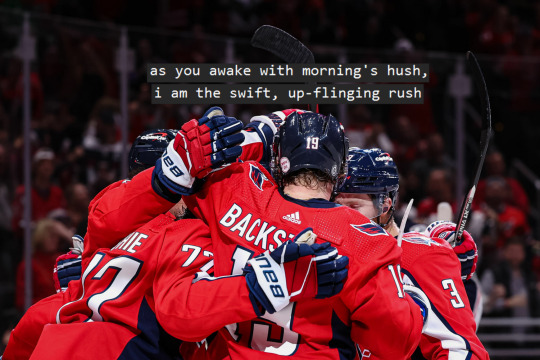
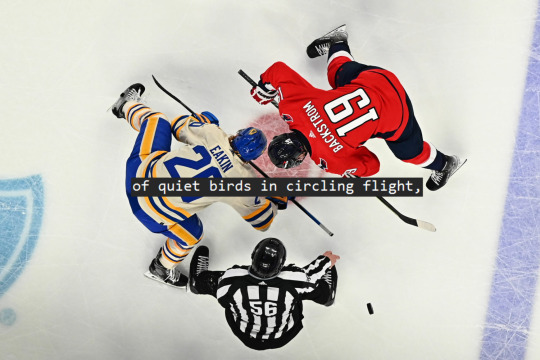
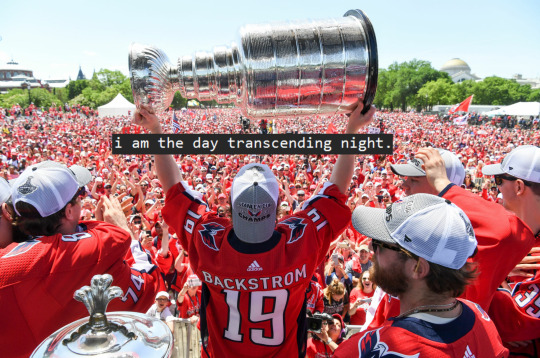
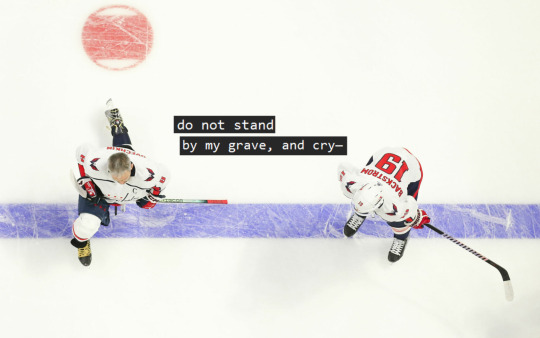
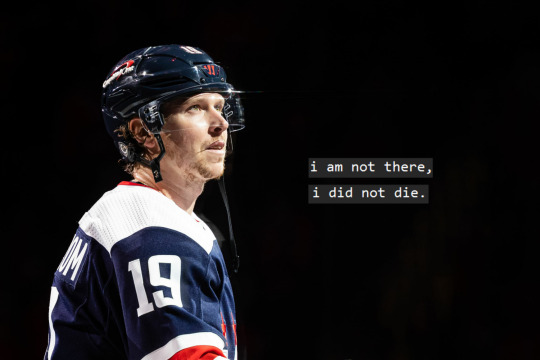
Nicklas Bäckström & the Washington Capitals (+ nickeovi) ― Immortality, Clare Harner | insp.
credits: x. x. x. x. x. x. x. x. x. x.
#uh. it has not been done yet right?#because the whole thing was kickstarted by another nicke post with a caption that read something like#“he really did say do NOT weep on my grave you're so annoying”#but i cant find it anymore#edit: found it! tysm @lafragolina <3#& by association i did not find other edits w nicke and this poem in particular#so i hope i did not rip anyone off -- in case let me know i'll delete#apropos of this poem i don't know how common knowledge it is (i did not know for once but i also do not read poetry that often so)#it is often attribuited to the wrong author one mary elizabeth frye who used to hand out copies of this poem w her name attached to it#she even changed some lines! anyway i linked the wiki article if you wanna check out more info -- its interesting#nicklas backstrom#nicklas bäckström#alexander ovechkin#washington capitals#nickeovi#819#hockey rpf#hockey stuff#hockey poetry
231 notes
·
View notes
Text
Making an AU where Edwin has incomplete paraplegia and chronic pain, pls lmk if you have any details that would make my writing 4 it better!!!🙏🙏🙏
#tetris belies it’s wisdom upon thee#dbda#dead boy detectives#edwin payne#my Gamgam had muscular dystrophy#so i know sum things abt mobile disabilities and wheelchairs & shit#but ik muscular dystrophy is different & *I* have never had any physical disabilities#rest assured i will read articles & do my own research too#knowledge is my drug🤓☝️
37 notes
·
View notes